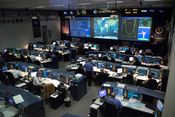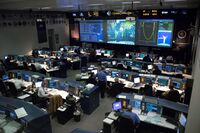مركز جونسون للفضاء
Lyndon B. Johnson Space Center | |
 Top to bottom, left to right: Aerial view of JSC with Space Center Houston in the foreground, Space Vehicle Mockup Facility, Christopher C. Kraft Jr. Mission Control Center, Neutral Buoyancy Laboratory, and the Space Center Houston Saturn V exhibit. | |
| الاختصار | JSC |
|---|---|
| سبقها | Space Task Group |
| التشكل | 1 نوفمبر 1961[1] |
| الموقع | |
| المالك | NASA |
Director | Vanessa E. Wyche |
الطاقم | 3,200 civil service |
| الموقع الإلكتروني | JSC home page |
الاسم السابق | Manned Spacecraft Center |
مركز جونسون للفضاء JOHNSON SPACE CENTER مقر رئاسة مشاريع مركبات الفضاء الأمريكية المأهولة التي تديرها الإدارة الوطنية للطيران وعلوم الفضاء (ناسا). والاسم الكامل للمركز هو مركز ليندون بي جونسون للفضاء. وكان يُسمَّى سابقًا مركز المركبات الفضائية المأهولة. يغطي المركز نحو 650 هكتارًا في هيوستن بتكساس.
مهام المركز
يُستعمل المركز مقرًّا لتدريب رواد الفضاء الأمريكيين. وبعد إقلاع أي مركبة فضائية بالمركز، من كيب كنفرال، فإنَّ مركز التحكم في المهمة بمركز جونسون يتحكم في الرحلة الجوية. يراقب مركز التحكم في المهمة مختلف الأنظمة التي تحافظ على حياة رواد الفضاء وعلى أداء المركبة الفضائية لمهامها.
يشرف المهندسون في مركز جونسون على تصميم المركبة الفضائية وتطويرها وبنائها. وتُبنَى المراكب الفضائية في مصانع، ثم تُفحص فحصًا دقيقًا في المركز. وتُوجد بالمركز غرفٌ خاصة، يتم فيها محاكات الطيران والفراغ الفضائي والتغيرات الهائلة في درجة الحرارة في الفضاء وعلى القمر.
تاريخ

بدأ بناء مركز جونسون للفضاء عام 1962. وأصبح المركز المقر الرئيسيّ لبرنامج مركبات الفضاء الأمريكية المأهولة عام 1964. وجه العلماء والمهندسون من المركز أول هبوط لرواد فضاء على سطح القمر في يوليو عام 1969. وسمي المركز في فبراير عام 1973 باسم الرئيس الأسبق ليندون بي جونسون، تخليدًا لذكراه.

المنشآت
The Johnson Space Center is home to Christopher C. Kraft Jr. Mission Control Center (MCC-H), the NASA control center that coordinates and monitors all human spaceflight for the United States. MCC-H directed all Space Shuttle missions, and currently directs American activities aboard the International Space Station. The Apollo Mission Control Center, a National Historic Landmark, is in Building 30. From the moment a crewed spacecraft clears its launch tower until it lands back on Earth, it is in the hands of Mission Control. The MCC houses several Flight Control Rooms, from which flight controllers coordinate and monitor the spaceflights. The rooms have many computer resources to monitor, command, and communicate with spacecraft. When a mission is underway, the rooms are staffed around the clock, usually in three shifts.[بحاجة لمصدر]
JSC handles most of the planning and training of the U.S. astronaut corps and houses training facilities such as the Sonny Carter Training Facility and the Neutral Buoyancy Laboratory, a critical component in training astronauts for spacewalks. The Neutral Buoyancy Laboratory provides a controlled neutral buoyancy environment—a very large pool containing about 6.2 million U.S. gallons (23,000 m3) of water where astronauts train to practice extra-vehicular activity tasks while simulating zero-g conditions.[2][3] The facility provides preflight training in becoming familiar with crew activities and with the dynamics of body motion under weightless conditions.[4]
Building 31-N houses the Lunar Sample Laboratory Facility, which stores, analyzes, and processes most of the samples returned from the Moon during the Apollo program.[بحاجة لمصدر]
The center is also responsible for direction of operations at White Sands Test Facility in New Mexico, which served as a backup Space Shuttle landing site and would have been the coordinating facility for the Constellation program, which was planned to replace the Shuttle program after 2010, but was canceled in 2009.[بحاجة لمصدر]
The visitor center has been the adjacent Space Center Houston since 1994; JSC Building 2 previously housed the visitor center.[بحاجة لمصدر]
The Johnson Space Center Heliport (FAA LID: 72TX) is located on the campus.[5]
الأفراد والتدريب


About 3,200 civil servants, including 110 astronauts, are employed at Johnson Space Center. The bulk of the workforce consists of over 11,000 contractors. As of October 2014, Stinger Ghaffarian Technologies took over United Space Alliance's primary contract.[6] اعتبارا من يونيو 2021[تحديث] the center's director is Vanessa E. Wyche.[بحاجة لمصدر]
NASA's astronaut training is conducted at the Johnson Space Center. Astronaut candidates receive training on spacecraft systems and in basic sciences including mathematics, guidance and navigation, oceanography, orbital dynamics, astronomy, and physics.[4] Candidates are required to complete military water survival prior to beginning their flying instruction. Candidates are also required to become scuba-qualified for extravehicular training and are required to pass a swimming test.[7][8] EVA training is conducted at the Sonny Carter Training Facility. Candidates are also trained to deal with emergencies associated with hyperbaric and hypobaric atmospheric pressures and are given exposure to the microgravity of space flight.[4] Candidates maintain their flying proficiency by flying 15 hours per month in NASA's fleet of T-38 jets based at nearby Ellington Field.[9]
الأبحاث
Johnson Space Center leads NASA's human spaceflight-related scientific and medical research programs. Technologies developed for spaceflight are now in use in many areas of medicine, energy, transportation, agriculture, communications, and electronics.[10]
The Astromaterials Research and Exploration Science (ARES) office performs the physical science research at the center. ARES directs and manages all functions and activities of the ARES scientists who perform basic research in earth, planetary, and space sciences. ARES scientists and engineers provide support to the human and robotic spaceflight programs. The responsibilities of ARES also include interaction with the Office of Safety and Mission Assurance and the Human Space Flight Programs[broken anchor].[11]
Johnson Space Center was granted a five-year, $120-million extension of its agreement with the National Space Biomedical Research Institute at Baylor College of Medicine to study the health risks related to long-duration space flight. The extension will allow a continuation of biomedical research in support of a long-term human presence in space started by the institute and NASA's Human Research Program through 2012.[12]
The Prebreathe Reduction Program is a research study program at the JSC that is currently being developed to improve the safety and efficiency of space walks from the International Space Station.[13]
The Overset Grid-Flow software was developed at Johnson Space Center in collaboration with NASA Ames Research Center. The software simulates fluid flow around solid bodies using computational fluid dynamics.[بحاجة لمصدر]
The Texas Space Commission was established by Texas governor Greg Abbott on March 26, 2024 at Johnson Space Center.[14]
تقاعد مكوك الفضاء
JSC put in a bid to display one of the retired Space Shuttle orbiters, but was not selected.[15]
معرض
A 2010 photo of JSC from the International Space Station
Space Shuttle Challenger atop its Shuttle Carrier Aircraft over JSC in 1983
Mission Control Center in 2005
انظر أيضاً
- Johnson Space Center shooting
- Yuri Gagarin Cosmonaut Training Center
- Mission Control Center
- Neutral Buoyancy Laboratory
- Ellington Field
- List of NASA contractors
- Robert R. Gilruth
الهامش
- ^ Grimwood (1963), p. 152.
- ^ Strauss S (July 2008). "Space medicine at the NASA-JSC, neutral buoyancy laboratory". Aviat Space Environ Med. 79 (7): 732–3. PMID 18619137.
- ^ Strauss S, Krog RL, Feiveson AH (May 2005). "Extravehicular mobility unit training and astronaut injuries". Aviat Space Environ Med. 76 (5): 469–74. PMID 15892545. Retrieved 2008-08-27.
- ^ أ ب ت NASA. "Astronaut Selection and Training". Archived from the original on 1999-04-27. Retrieved 2008-08-27.
- ^ "AirNav: 72TX - Johnson Space Center Heliport".
- ^ "NASA Awards Mission Operations Support Contract". NASA.gov. NASA. 14 July 2014.
- ^ Fitzpatrick DT, Conkin J (2003). "Improved pulmonary function in working divers breathing nitrox at shallow depths". Undersea Hyperb Med Abstract. 30 (Supplement): 763–7. PMID 12862332. Archived from the original on August 11, 2011. Retrieved 2008-08-27.
{{cite journal}}: CS1 maint: unfit URL (link) - ^ Fitzpatrick DT, Conkin J (July 2003). "Improved pulmonary function in working divers breathing nitrox at shallow depths". Aviat Space Environ Med. 74 (7): 763–7. PMID 12862332. Retrieved 2008-08-27.
- ^ Siceloff, Steven (20 April 2011). "T-38s Soar as Spaceflight Trainers". NASA.
- ^ NASA. Johnson Space Center: Exploring the science of space for the future of Earth. NASA. Archived from the original. You must specify the date the archive was made using the
|archivedate=parameter. http://www.nasa.gov/centers/johnson/pdf/167745main_FS_JSC508c.pdf. Retrieved on 2008-08-27. - ^ "Astromaterials Research Office". Johnson Space Center. Archived from the original on أكتوبر 10, 2009. Retrieved أكتوبر 18, 2009.
- ^ "Johnson Space Center to continue biomedical research". Houston Business Journal. 2007-10-02. Retrieved 2009-10-18.
- ^ "Comparison of V-4 and V-5 Exercise/Oxygen Prebreathe Protocols to Support Extravehicular Activity in Microgravity". NASA Technical Reports. Retrieved 2009-10-18.
- ^ "Gov. Greg Abbott announces launch of Texas Space Commission at Johnson Space Center in Houston". khou.com (in الإنجليزية الأمريكية). 2024-03-26. Retrieved 2024-03-27.
- ^ Berger, Eric. "Houston we've had a problem: 'Space City' snubbed in bid for retired space shuttle". Houston Chronicle. Archived from the original on أبريل 17, 2011. Retrieved أبريل 12, 2011.
المصادر
وصلات خارجية
- Lyndon B. Johnson Space Center
- Suddenly, tomorrow came... A history of the Johnson Space Center (PDF format) 1993
- NASA Johnson Space Center Oral History Project - Interview with Thomas W. 'Tommy' Holloway
- "America's Space Program: Exploring a New Frontier", a National Park Service Teaching with Historic Places (TwHP) lesson plan
- Aviation: From Sand Dunes to Sonic Booms, a National Park Service Discover Our Shared Heritage Travel Itinerary
خطأ لوا في وحدة:Authority_control على السطر 278: attempt to call field '_showMessage' (a nil value). 29°33′30″N 95°05′20″W / 29.55833°N 95.08889°W
- Harv and Sfn no-target errors
- CS1 maint: unfit URL
- CS1 الإنجليزية الأمريكية-language sources (en-us)
- Pages using gadget WikiMiniAtlas
- Short description is different from Wikidata
- Articles with hatnote templates targeting a nonexistent page
- Articles with unsourced statements from January 2021
- مقالات فيها عبارات متقادمة منذ يونيو 2021
- جميع المقالات التي فيها عبارات متقادمة
- Articles with unsourced statements from February 2021
- Pages with broken anchors
- Pages with empty portal template
- Coordinates on Wikidata
- Johnson Space Center
- Buildings of the United States government in Texas
- NASA facilities
- Buildings and structures in Houston
- Tourist attractions in Houston
- Space technology research institutes
- Economy of Houston
- 1961 establishments in Texas
- Lyndon B. Johnson
- Oral history
- Government buildings completed in 1961
- Apollo program facilities
- مرافق ناسا









